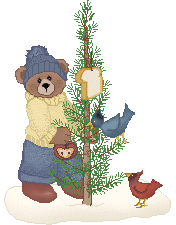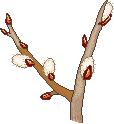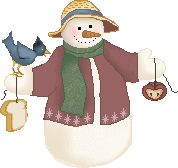



![]() Annie's Bird Page
Annie's Bird Page ![]()

"Where the birds make their nests: [as for]
the stork,
the fir trees [are] her house."
~Psalm 104:17~

National Bird Day is January 5th Each Year!

What does the Bible say about "Birds?"
Bird Bible Verses
There
are 14 verses with "bird" and verse with 25 verses
with "birds".
"The flowers appear on the
earth; the time of the singing [of birds]
is come, and the voice of the turtle is heard in our land;"
~Song of Solomon 2:12~
INHABIT
MAKE
THEIR NESTS CALLED
|

Birds
in the Bible are categorized in two groups.
Clean
& Unclean!
This tells us whether the bird is
safe and fit to eat or not.
CLEAN
Birds: UNCLEAN
Birds: |

Why Birds Migrate?
"Each
year with great regularity most species of birds return to their summer
homes, court and choose their mates, build their nests, lay eggs,
and rear their young. In the late summer and fall they acquire
their new plumage. Then they join with others of their kind in
large or small flocks, feeding and storing up fat in their
bodies. Thus they prepare for the hardships of winter, whether
they are to remain in the cold northlands or make a strenuous
journey to the south.
While scientists have much to learn about bird migration, they think they know some of the reasons birds feel the need to migrate: chemical changes inside their bodies, changes in weather, and changes in day length.
Once they get moving, how do birds know where to go? In some species, very young birds find their way to places their parents have been migrating to for years, even though they have never been there before and their parents don't help them!
Many scientists think that birds are born with a sense of direction that tells them where to go, and that birds use the sun, moon, and stars to figure out where they are, much like early sailors did."
Winter Feeding of Birds

"Winter
is not only the best time to feed birds--it is the most necessary
time. It is then that insects, seeds, and berries are hard to
find. Feeding is most important after ice storms and heavy
snowfalls have covered natural food supplies. If feeding is begun
it must be kept up until spring. Birds become dependent on a food
tray. They may suffer or even die if feeding is stopped in
midwinter.
Hang feeders out of reach of squirrels and night prowlers, such as opossums and raccoons. These wild animals should have their own feeders on the ground. Bird feeders can be protected by metal guards or hung from the end of a branch. Squirrels are expert tightrope walkers. Hanging a feeder from a wire between two trees will not keep squirrels away. Sparrows and juncos prefer to feed on the ground. Scatter their food at the base of a tree. Birds feed most frequently in the morning and evening."
The Hobby of Bird Study
![]()
"Bird-watching
is a hobby that can be enjoyed for a lifetime. In bird clubs the
membership ranges in age from young children to grandparents.
Bird study is anything you want to make of it. It may take hard
work--wading through swamps, pushing across pathless fields, and
scrambling up and down mountainsides. Or it may also be enjoyed
by just looking from a window.
Bird study can combine healthful outdoor activity with the pursuit of beauty and knowledge. Every bird when it is seen for the first time brings a thrill of discovery. The spring migration is a fresh wonder every year. The surprise and delight of coming across a rarity and the very difficulty of keeping it in view long enough to be sure of what it is help to make bird study an endless fascination.
With a field guide and binoculars, you can carry the hobby of bird study wherever you go. Vacations are enriched with the observation of species not to be found in your home territory. Many soldiers sent to far parts of the world have become acquainted with the birds of Iceland, Korea, Germany, or other countries where they were stationed."
![]()
How
to Study Birds
"The only equipment necessary
for bird study is a field guide with good color pictures, and a
pair of binoculars. Some bird watchers also carry along a good
camera, with color film, in case the opportunity presents itself
to get pictures.
Some birders want to develop a life list of many hundreds of species, which requires good binoculars. Even the best of unaided eyes cannot see the fine points that determine difficult identifications of species that look alike.
The color and markings of a bird's plumage--its field marks--are learned first. Many birds can also be recognized by their shapes as they perch and fly. The way a bird flies and the way it acts help to identify it. For example, five different thrushes are seen during migration in the north-central United States. You know a hermit thrush by the nervous way it raises and lowers its tail. A flock of goldfinches high in the air can be identified by its roller-coaster flight pattern.
It is not always necessary, however, to see all of the bird. Many birds have flash marks that identify them. A robin-sized bird with a very conspicuous white rump is undoubtedly a flicker. A small slate-gray bird with white outer tail feathers is a junco. A brown sparrow with white outer tail feathers is the vesper sparrow."
![]()
How to Study Bird Songs
"Bird songs should be learned
at the same time as the field marks. Knowledge of songs not only
enriches the hobby but makes identification much easier. Some
migrating birds can be safely identified only by their songs. The
alder, least, and Acadian flycatchers are so much alike that they
are almost impossible to distinguish in the field. Their songs,
however, are totally different.
It is fun to be able to make a list of identifications of species you have recognized by ear only. For example, on a long automobile trip when you do not have the opportunity to hike, you can list all the birds you hear along the road. Birding by ear is a hobby that can also be taken up by the blind.
While you are learning a new song you have to track down the singer. This can be slow and discouraging. Sparrows, always sensitive to trespassers, flip through tall grasses and show themselves so briefly that the beginner has the greatest difficulty in getting all the field marks. Warblers move swiftly through the tops of high trees. Persistence is often a requirement for some aspects of bird-watching.
One of the simplest ways to learn bird songs is to listen to recordings. Play them many times during the winter so you will recognize them when you first hear them in the spring."

Some
Common Questions About Birds
Source: Excerpted from Compton's
Interactive Encyclopedia.
What is the largest living bird? The
ostrich, at more than 8 feet (2 meters) and 345
pounds (155 kilograms), is the tallest and heaviest, but it does
not fly. Of the flying
birds the wandering albatross has the greatest wingspan at over
11 feet (3 meters); the
great bustard, at 46 pounds (21 kilograms), and the mute swan, at
30 pounds (13.6
kilograms), are the heaviest flying birds.
What is the smallest living bird? The Cuban
bee hummingbird, at 2 1/4 inches
(6 centimeters) and 0.07 ounce (2 grams).
How far do birds fly? The arctic
tern makes an annual round-trip of 11,000 miles (17,700
kilometers) between the Arctic and the Antarctic. Warblers make
the longest, more than
2,000 miles (3,200 kilometers), nonstop flights.
How
fast do birds fly? Most birds average 20 to 40 miles
(32 to 64 kilometers) per hour
in normal flight. They can almost double this speed for escape or
pursuit. The champion is
the peregrine falcon. It strikes its prey while diving at an
average of 112 miles
(180 kilometers) per hour.
How fast do birds run? The
ostrich, 60 miles (97 kilometers) per hour; wild turkey, 30
miles (48 kilometers) per hour; California roadrunner, 26 miles
(42 kilometers) per hour;
common pheasant, 21 miles (34 kilometers) per hour.
How high do birds fly? The highest
flying bird in the world is Ruppell's griffon vulture, a
specimen of which collided with a commercial aircraft at 37,000
feet (11,300 meters)
over Western Africa. Another notable specimen is the whooper
swan, which a pilot spotted
flying at 27,000 feet (8,200 meters) over the Inner Hebrides.
How long do birds live? The wild
bird with the longest recorded lifespan is the royal
albatross, which exceeds 58 years. The wandering albatross,
however, is suspected to live
more than 80 years in the wild. The longest-lived captive bird is
the sulfur-crested
cockatoo, which can live more than 80 years. Some general figures
are available.
Which are the most intelligent
birds? The green heron shows a remarkable
ability to learn
to respond to sight and sound cues. Members of the family
Corvidae--crows, ravens,
jackdaws, magpies, jays--appear to learn rapidly as well.
How many kinds of birds are there in
the world? About 30,000 varieties, divided into
some 8,600 to 8,900 species.
Bird Links

And you can go
bird watching right in your own backyard.
Well that is if you live in the South.
![]()
![]()
Send
a card From Annie's
Card Shop
Annie's
Featured Holiday Page |
Annie's
Featured Page |
Copyright
1998 - 2010 Annie's Home Page. All Rights Reserved. Source
for this page is
World Book Encyclopedia & the Bible. I thank the Lord for
graphics artists without them
these pages would not be the same. Please visit Annie's
List of Great Graphics Spots for
a list of their links. Some Graphics on this page from Mary's Little Lamb Graphics
& Graphic
Garden
& Country Tidbits Graphics. This site hosted by: Christian Web Host.
Silent
No Right Click Script from Dynamic Drive. For Instructions on how
to add the no
right click script visit: Annie's "How to Add
Silent No Right Click Script" Page.
Source: Excerpted material on this page from
Compton's Interactive Encyclopedia.

For a Listing of the Rest of my Pages:
![]()